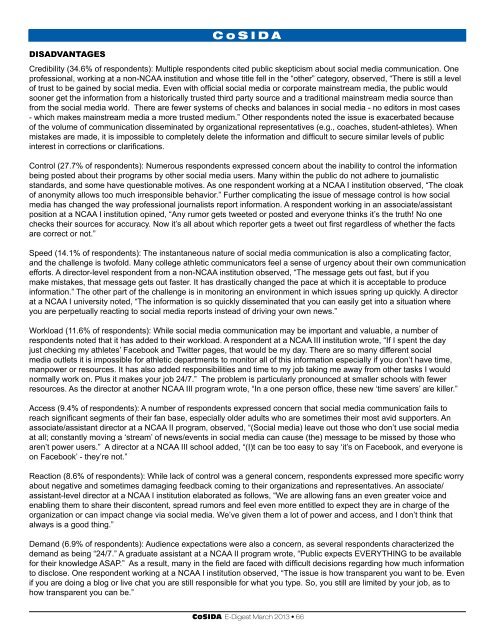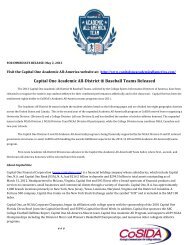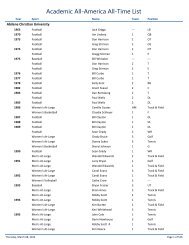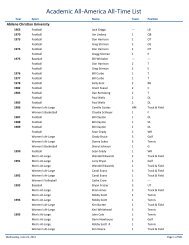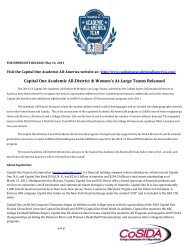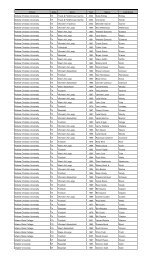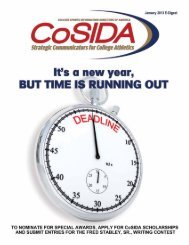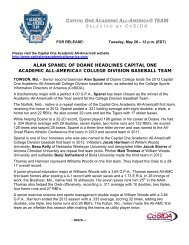CoSIDA E-Digest March 2013 • 1
CoSIDA E-Digest March 2013 • 1
CoSIDA E-Digest March 2013 • 1
Create successful ePaper yourself
Turn your PDF publications into a flip-book with our unique Google optimized e-Paper software.
<strong>CoSIDA</strong><br />
DISADVANTAGES<br />
Credibility (34.6% of respondents): Multiple respondents cited public skepticism about social media communication. One<br />
professional, working at a non-NCAA institution and whose title fell in the “other” category, observed, “There is still a level<br />
of trust to be gained by social media. Even with official social media or corporate mainstream media, the public would<br />
sooner get the information from a historically trusted third party source and a traditional mainstream media source than<br />
from the social media world. There are fewer systems of checks and balances in social media - no editors in most cases<br />
- which makes mainstream media a more trusted medium.” Other respondents noted the issue is exacerbated because<br />
of the volume of communication disseminated by organizational representatives (e.g., coaches, student-athletes). When<br />
mistakes are made, it is impossible to completely delete the information and difficult to secure similar levels of public<br />
interest in corrections or clarifications.<br />
Control (27.7% of respondents): Numerous respondents expressed concern about the inability to control the information<br />
being posted about their programs by other social media users. Many within the public do not adhere to journalistic<br />
standards, and some have questionable motives. As one respondent working at a NCAA I institution observed, “The cloak<br />
of anonymity allows too much irresponsible behavior.” Further complicating the issue of message control is how social<br />
media has changed the way professional journalists report information. A respondent working in an associate/assistant<br />
position at a NCAA I institution opined, “Any rumor gets tweeted or posted and everyone thinks it’s the truth! No one<br />
checks their sources for accuracy. Now it’s all about which reporter gets a tweet out first regardless of whether the facts<br />
are correct or not.”<br />
Speed (14.1% of respondents): The instantaneous nature of social media communication is also a complicating factor,<br />
and the challenge is twofold. Many college athletic communicators feel a sense of urgency about their own communication<br />
efforts. A director-level respondent from a non-NCAA institution observed, “The message gets out fast, but if you<br />
make mistakes, that message gets out faster. It has drastically changed the pace at which it is acceptable to produce<br />
information.” The other part of the challenge is in monitoring an environment in which issues spring up quickly. A director<br />
at a NCAA I university noted, “The information is so quickly disseminated that you can easily get into a situation where<br />
you are perpetually reacting to social media reports instead of driving your own news.”<br />
Workload (11.6% of respondents): While social media communication may be important and valuable, a number of<br />
respondents noted that it has added to their workload. A respondent at a NCAA III institution wrote, “If I spent the day<br />
just checking my athletes’ Facebook and Twitter pages, that would be my day. There are so many different social<br />
media outlets it is impossible for athletic departments to monitor all of this information especially if you don’t have time,<br />
manpower or resources. It has also added responsibilities and time to my job taking me away from other tasks I would<br />
normally work on. Plus it makes your job 24/7.” The problem is particularly pronounced at smaller schools with fewer<br />
resources. As the director at another NCAA III program wrote, “In a one person office, these new ‘time savers’ are killer.”<br />
Access (9.4% of respondents): A number of respondents expressed concern that social media communication fails to<br />
reach significant segments of their fan base, especially older adults who are sometimes their most avid supporters. An<br />
associate/assistant director at a NCAA II program, observed, “(Social media) leave out those who don’t use social media<br />
at all; constantly moving a ‘stream’ of news/events in social media can cause (the) message to be missed by those who<br />
aren’t power users.” A director at a NCAA III school added, “(I)t can be too easy to say ‘it’s on Facebook, and everyone is<br />
on Facebook’ - they’re not.”<br />
Reaction (8.6% of respondents): While lack of control was a general concern, respondents expressed more specific worry<br />
about negative and sometimes damaging feedback coming to their organizations and representatives. An associate/<br />
assistant-level director at a NCAA I institution elaborated as follows, “We are allowing fans an even greater voice and<br />
enabling them to share their discontent, spread rumors and feel even more entitled to expect they are in charge of the<br />
organization or can impact change via social media. We’ve given them a lot of power and access, and I don’t think that<br />
always is a good thing.”<br />
Demand (6.9% of respondents): Audience expectations were also a concern, as several respondents characterized the<br />
demand as being “24/7.” A graduate assistant at a NCAA II program wrote, “Public expects EVERYTHING to be available<br />
for their knowledge ASAP.” As a result, many in the field are faced with difficult decisions regarding how much information<br />
to disclose. One respondent working at a NCAA I institution observed, “The issue is how transparent you want to be. Even<br />
if you are doing a blog or live chat you are still responsible for what you type. So, you still are limited by your job, as to<br />
how transparent you can be.”<br />
<strong>CoSIDA</strong> E-<strong>Digest</strong> <strong>March</strong> <strong>2013</strong> <strong>•</strong> 66


